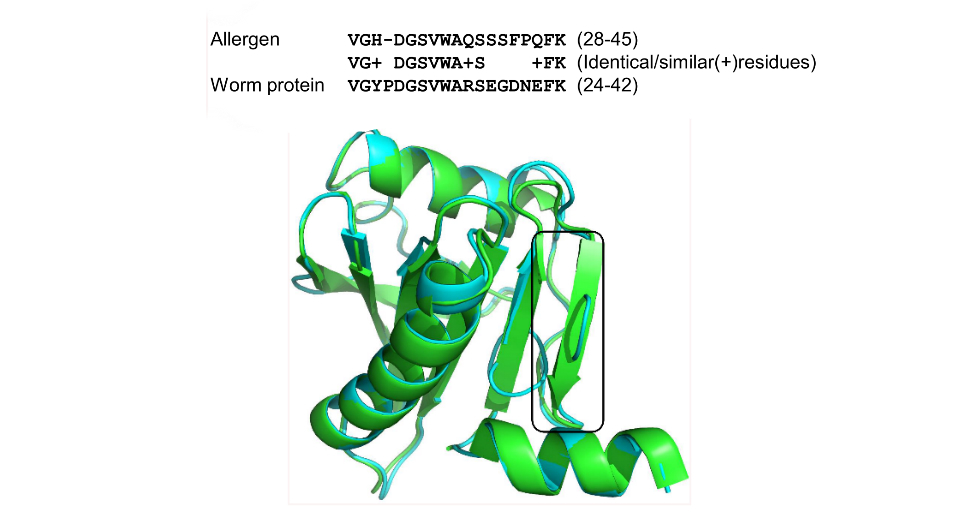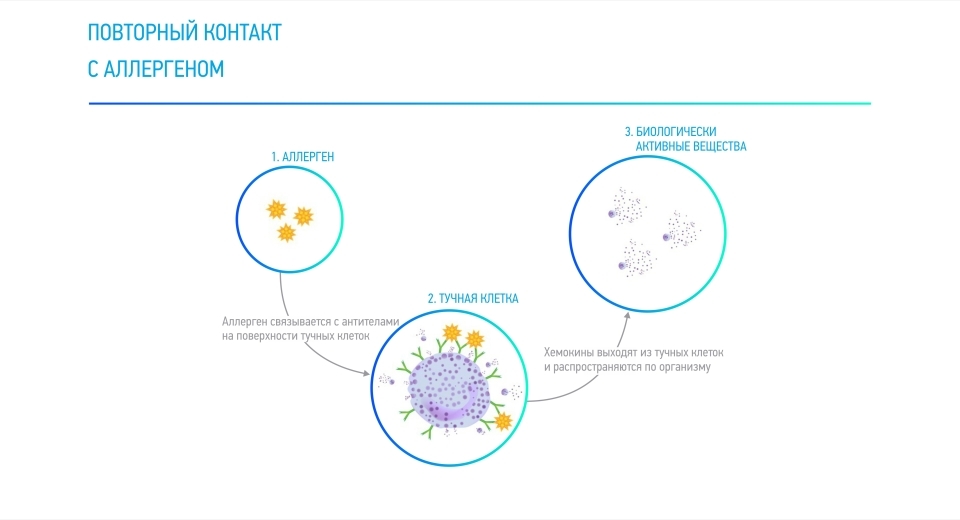How does pollen allergy come about?
We welcome everyone in the blog of the company Tion . We continue the theme of pollen and pollinosis. We already wrote about how allergenic pollen looks and how much it flies around us. Now we will analyze at the cellular level, why and how there is an allergy to pollen.

Allergenic proteins in pollen are similar in composition to proteins of parasitic worms. This is the discovery of British scientists (real, not memes).
Take for example the protein that human roundworm emits. And compare it with the protein Bet V1, which is contained in birch pollen. It turned out that they coincide by 27%. Moreover, it is precisely those parts of proteins that the immune system responds to. These portions of proteins are called epitopes . The picture below shows a 3D model of proteins: blue from roundworm, green from pollen. The frame highlighted their epitopes in the text above the molecules - a sequence of epitopes. As you can see, they are really similar.
')

Vegetable protein Bet V1 does not affect health. But because of such a suspicious epitope, our immune system responds to birch protein as if it were a roundworm. So harmless pollen becomes an allergen.
In total, scientists have found 1,400 such analogies between plants and parasites. It turns out that allergy is the price we pay for immunity to parasitic infections.
Interesting fact: the less often a person contacts with parasites, the sharper he reacts to pollen. In third world countries with poor hygienic conditions, people are less likely to suffer from allergies. If they emigrate to developed “clean” countries, their sensitivity to allergens increases over time. This is indicated by statistical studies. The explanation of this pattern is simple. The same immune cells and proteins are involved in reactions to parasites and pollen. And if they are spent on parasites, then they simply are not enough for pollen.
An allergic response is a chain reaction in which various immune cells and proteins are involved. A short video about how this happens:
(Video in English, but everything is clear and without subtitles)
For those who want to learn more, below described in detail the mechanism of the appearance of allergies. It happens in three stages.
The actors in the first stage are antigen presenting cells, T cells, B cells and mast cells. Each has its own role.
It all starts when a person inhales allergenic pollen. For example, birch. Pollen grains pass through the mucous membrane of the nasal cavity and enter the body.
Antigen- presenting cells are the first to attack the pollen. They "digest" it and turn it into small proteins. In the case of birch, this is the same Bet V1. This is the pollen antigen, or allergen .
Allergen is the ignition key. He “turns on” T-cells , and they send a distress signal to the body: “Attention! In the body allergen! And not just an allergen, but Bet V1 ”. B-cells and mast cells react to this SOS-signal.
B cells produce IgE immunoglobulins, which are specific to the birch allergen.
IgE - antibodies, key proteins in the immune response. In the next step, they will bind the allergen and launch a protective immune response.
Mast cells in response to the SOS-signal begin to multiply actively. There are many receptors on their surface, joined by IgE antibodies.

The intermediate result of the first stage: in the body a lot of mast cells, "overgrown" from all sides with IgE immunoglobulin. This immunoglobulin contains information about a specific allergen (Bet V1). So the immune system "remembered" the birch allergen and prepared for repeated attacks. When you first contact with the pollen allergy symptoms yet.
The second stage is simple, only one actor is involved in it - mast cells already familiar to us.
It all starts with repeated contact with the Bet V1 allergen. The immune system already knows it and immediately binds mast cells with IgE antibodies.
After binding to the allergen inside the mast cells, granules with special biologically active substances, chemokines , burst. These include histamine, platelet activating factors (TAF), leukotrienes and prostaglandins. All of these substances change a person’s well-being.

The intermediate result of the second stage: biologically active substances “travel” around the body. From where they go, depends on human health.
For each substance from the second stage, different cells of the body have their own receptors. Take histamine. Four types of histamine receptors are known for it: H1, H1, H3 and H4. Each receptor triggers a different body response to histamine.

Other biologically active substances also trigger allergic symptoms:
The result of the third stage and the entire allergic response in general - shortness of breath, cough, runny nose, tears from the eyes, irritation of the skin. These symptoms will appear in the allergy at each meeting with the allergen.
Allergen can get into the body not only with pollen. The same protein Bet V1 is found in apples, peaches, pears, cherries, soybeans, peanuts, hazelnuts, carrots, parsley and other food plants. So allergy to birch pollen develops into a food allergy. This is called a "cross allergic reaction."
It is easy to protect yourself from food allergens: it is enough to exclude "dangerous" products from the diet. Pollen protection is more difficult. And it is even more difficult to train your immunity so that it ignores allergens and does not start a chain allergic reaction.
We will write next time about how to protect yourself from pollen in the air and how to treat allergies.
Read more about how much pollen is in the air and what kind of pollen causes allergies.


Why pollen causes allergies
Allergenic proteins in pollen are similar in composition to proteins of parasitic worms. This is the discovery of British scientists (real, not memes).
Take for example the protein that human roundworm emits. And compare it with the protein Bet V1, which is contained in birch pollen. It turned out that they coincide by 27%. Moreover, it is precisely those parts of proteins that the immune system responds to. These portions of proteins are called epitopes . The picture below shows a 3D model of proteins: blue from roundworm, green from pollen. The frame highlighted their epitopes in the text above the molecules - a sequence of epitopes. As you can see, they are really similar.
')

Vegetable protein Bet V1 does not affect health. But because of such a suspicious epitope, our immune system responds to birch protein as if it were a roundworm. So harmless pollen becomes an allergen.
In total, scientists have found 1,400 such analogies between plants and parasites. It turns out that allergy is the price we pay for immunity to parasitic infections.
Interesting fact: the less often a person contacts with parasites, the sharper he reacts to pollen. In third world countries with poor hygienic conditions, people are less likely to suffer from allergies. If they emigrate to developed “clean” countries, their sensitivity to allergens increases over time. This is indicated by statistical studies. The explanation of this pattern is simple. The same immune cells and proteins are involved in reactions to parasites and pollen. And if they are spent on parasites, then they simply are not enough for pollen.
How pollen causes allergies
An allergic response is a chain reaction in which various immune cells and proteins are involved. A short video about how this happens:
(Video in English, but everything is clear and without subtitles)
For those who want to learn more, below described in detail the mechanism of the appearance of allergies. It happens in three stages.
Stage 1: the first contact with the allergen and the appearance of "immune memory"
The actors in the first stage are antigen presenting cells, T cells, B cells and mast cells. Each has its own role.
It all starts when a person inhales allergenic pollen. For example, birch. Pollen grains pass through the mucous membrane of the nasal cavity and enter the body.
Antigen- presenting cells are the first to attack the pollen. They "digest" it and turn it into small proteins. In the case of birch, this is the same Bet V1. This is the pollen antigen, or allergen .
Allergen is the ignition key. He “turns on” T-cells , and they send a distress signal to the body: “Attention! In the body allergen! And not just an allergen, but Bet V1 ”. B-cells and mast cells react to this SOS-signal.
B cells produce IgE immunoglobulins, which are specific to the birch allergen.
IgE - antibodies, key proteins in the immune response. In the next step, they will bind the allergen and launch a protective immune response.
Mast cells in response to the SOS-signal begin to multiply actively. There are many receptors on their surface, joined by IgE antibodies.

The intermediate result of the first stage: in the body a lot of mast cells, "overgrown" from all sides with IgE immunoglobulin. This immunoglobulin contains information about a specific allergen (Bet V1). So the immune system "remembered" the birch allergen and prepared for repeated attacks. When you first contact with the pollen allergy symptoms yet.
Stage 2: re-contact with the allergen and the "launch" of mast cells
The second stage is simple, only one actor is involved in it - mast cells already familiar to us.
It all starts with repeated contact with the Bet V1 allergen. The immune system already knows it and immediately binds mast cells with IgE antibodies.
After binding to the allergen inside the mast cells, granules with special biologically active substances, chemokines , burst. These include histamine, platelet activating factors (TAF), leukotrienes and prostaglandins. All of these substances change a person’s well-being.

The intermediate result of the second stage: biologically active substances “travel” around the body. From where they go, depends on human health.
Stage 3: the appearance of allergic symptoms
For each substance from the second stage, different cells of the body have their own receptors. Take histamine. Four types of histamine receptors are known for it: H1, H1, H3 and H4. Each receptor triggers a different body response to histamine.
- Histamine + H1 Receptors
The permeability of the membranes between the blood vessels and tissues increases. The fluid passes through this membrane more easily and accumulates in the tissues, swelling, runny nose and watery eyes appear. Nerve endings in the skin and mucous membranes are irritated, urticaria, itching appear. The walls of the bronchi are compressed, bronchospasms, coughing and shortness of breath appear. - Histamine + H2 receptors
Hydrochloric acid and digestive enzymes are released. Increases the risk of gastritis or stomach ulcers. - Histamine + H3 Receptors
Neurotransmitters are developed, the speed of transmission of nerve signals increases. The brain is faster. - Histamine + H4 receptors
The cells of the immune system multiply, the immune response and allergic symptoms increase.

Other biologically active substances also trigger allergic symptoms:
- Thromobactivating factors (TAF)
Greetings from the captain of evidence: TAF activates platelets. And platelets, in turn, secrete histamine and serotonin. Serotonin causes bronchospasm (cough). What histamine does, we already know. - Leukotrienes and prostaglandins
These substances enhance the contraction of smooth muscles, cause attacks of sneezing and coughing.
Conclusion
The result of the third stage and the entire allergic response in general - shortness of breath, cough, runny nose, tears from the eyes, irritation of the skin. These symptoms will appear in the allergy at each meeting with the allergen.
Allergen can get into the body not only with pollen. The same protein Bet V1 is found in apples, peaches, pears, cherries, soybeans, peanuts, hazelnuts, carrots, parsley and other food plants. So allergy to birch pollen develops into a food allergy. This is called a "cross allergic reaction."
It is easy to protect yourself from food allergens: it is enough to exclude "dangerous" products from the diet. Pollen protection is more difficult. And it is even more difficult to train your immunity so that it ignores allergens and does not start a chain allergic reaction.
We will write next time about how to protect yourself from pollen in the air and how to treat allergies.
Read more about how much pollen is in the air and what kind of pollen causes allergies.

Source: https://habr.com/ru/post/392365/
All Articles